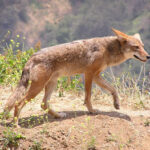Coyotes are mainly nocturnal scavengers and the best time to hunt coyotes is an hour before and after light and anytime during dark hunters although daytime hunting can be very successful. Coyotes are usually on the move after dark looking for an easy meal so it may be a good chance to call in and harvest one. Coyote populations are on the rise therefore raising chances and success rates of harvesting these incredible animals.
Winter (October- January):
Early in the season family groups have split up, but pups from this year aren’t too far from Mom and Dad usually until seasons end. This is a prime time to hunt coyotes, prey is abundant and distress sounds will bring in young(uneducated) pups in. Any type of locator howl will work good this time of year, toward seasons end food supply drops and distress sounds become a go to call. Late nearing end of January, Coyotes enter breeding season and pups are pushed out on their own by the dominant pair. Locator howls at this time can work and distress sounds may draw in a curious coyote or possibly a fox, but they are mainly concentrating on breeding and aren’t too interested in much else.
Spring(January-June):
This is a harder time of the year to hunt predators, they’re usually involved in raising pups and don’t concentrate on much else. Challenged barks can work to get them interested in finding who’s on their turf. Coyote pairs are extremely protective of den sites and usually don’t venture too far away from it, so set up close to known den sites. Distress calls work ok but mostly coyotes stick to raising pups, if you located a den site try a distress sound or a locator/challenge bark and you might pull in a curious coyote.
Summer)July-September):
Things finally start heating up after breeding and pup rearing, family groups get ready to break up. Pups are venturing out of den areas and start hunting with Mom and Dad and toward seasons end they’ll be hunting in small packs with siblings. This time both distress and howlers start picking up again, try short sequences of distress sounds followed by a locator howl. Also any Coyote Pup Distress is an excellent choice as Mom and Dad will investigate to help a pup, possibly theirs.
Fall(Late September- October):
Family groups are breaking up around now and there’s a lot of young Coyotes with food and survival on their minds. Food is still abundant and the young juvenile coyotes have a very hard time turning down an easy meal. This time distress sounds work great and the younger coyotes can be comical as they come in doubles or more. If you’re using barks or howls, make them imitate young coyotes. if you bark like a big dog on the block it will almost always make everything quite down until they find out who the big dog is.
Good Calls to Use
Although there are a lot of new coyote howlers, distress calls and decoys entering the market every day here are a list of my favorites that have produced a lot of success.
- Foxpro Firestorm
- Dan Thompson Red Dessert Howler CH-1
- Predator Sniper Coyote Howler 2 pack # CPHP
- Dan Thompson Long Range Cottontail PC-2
- Johnny Stewart Predator Distress # PC-7
- Primos/Randy Anderson Double Cottontail # 365
- MAD/Flambeau “Lone Howler” Coyote/Predator Decoy # 5985
- Mojo Outdoors Critter Predator Decoy # HW5121
There are many different makes, models and colors of calls on the market today but you just have to experiment with them while in the field to see which one has better success, all areas wont have the same success due to different reasons.
Scouting for Coyotes
In order to find productive and potential spots is to scout them out first. Tracks are a good indication that one or more are in the area, coyote tracks are sort of arrowhead shaped as pose to domestic dogs which are round. Coyotes also walk in a almost perfectly straight line making it very noticeable to pick them out in snow, mud or dirt. If you have a vantage point to oversee a large terrain, use binoculars or a spotting scope to locate possible dens, travel routes or you may even located a coyote on the prowl in search of food. Also look for coyote scat, it will usually contain hair and small bone chunks, the shape closely resembles a sausage link. Coyotes feed on small animals, birds and a variety of food found around cattle areas.
There is also the opportunity to do some scouting via satellite/internet. There are many internet websites available with topo maps and tools needed to help scout out locations without leaving home. Topo Maps give you the chance to see what kind of terrain is around your location including wood lots, creeks and open terrain giving you more choices on where to scout and choose set up locations.
Another way of scouting is going to potential spots(mainly after dark) pulling off along the road, turning off your vehicle and calling. Using locator calls to pinpoint coyote pack locations and take note to the time and location of the response to remember these spots for future setups. This method should be done on a regular basis to sort of pattern the coyotes night time travel habits and locations.
Helpful Tools for Scouting:
- GPS
- Notebook to mark locations
- Spotting Scope or Binoculars
- Locator Call
- Internet Access
Guns and Ammo to Use
There are many different makes, models and calibers of rifles and shotguns on the market but the most important gun(s) you want for coyote hunting is one that fits. A shotgun that doesn’t fit properly will shoot high, low and sometimes not even on target. Also a very important tip is to practice a lot with both shotgun and rifle to get comfortable and good with your firearm.
For Rifles cartridges I prefer the .223, .22-250, .204 Ruger or . 243, all are very accurate flat shooting calibers. Pretty much any .22 caliber rifle will take a coyote cleanly, I’ve even used a .22 magnum rimfire in doing so but this caliber has it’s limits along with good shot placement. You want to pick a bullet that’s between 40-60 grains, there are many different bullet configurations with several different brands of ammo just pick the one that is the most accurate and reliable out of your gun. My most accurate brand of ammo has bee Hornady V-Max.
For Shotguns I prefer a 12 gauge although a 20 gauge and 410 gauge will cleanly harvest a coyote within certain distances(40 yards or less.) I like the 12 gauge with a 3″ chamber and for ammo any turkey load will do the job, I’d recommend #5 shot. There are many aftermarket predator choke tubes and ammo available to which I would recommend Hevi-Shot Dead Coyote Choke Tube along with a box of 3″ dead coyote T-shot and you’ll have no problems harvesting a coyote out to 70+ yards. The action of the shotgun have no real value just as long as the gun fits is the most important.


